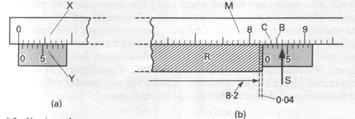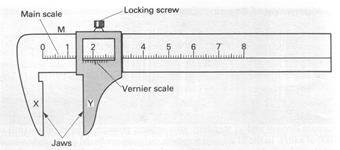System International units
A system of units, known as the System International (SI) units, is now used for all branches of physics. It is based on the meter as the unit of length, the kilogram as the unit of mass, the second as the unit of time, the ampere as the unit of electric current and the Kelvin as the unit of temperature. The unit of force in this system is the Newton and the unit of energy is the Joule. For many years the meter (m) was taken as the distance between two lines on a particular platinum-iridium rod at 00 C kept near Paris. It is now defined as the length of a certain number of wavelengths in a vacuum of a particular orange radiation of the krypton-86 atom. Unlike the distance between the marks on the rod, the wavelength of the radiation from an atom is a constant. By definition, 1 m = 1650763.73 wavelengths of the above radiation. The kilogram (kg) is the mass of a particular solid cylinder made of platinum-iridium alloy kept in Paris, known as the International Prototype Kilogram. In practice, the following smaller units may also be used. The millimeter (mm), which is 1/1000 m. The centimeter (cm), which is 1/100 m The gram (g), which is 1/1000 kg. The second (s) was formerly 1/86400 th part of a mean solar day. This unit, used by astronomers, has now been replaced by an atomic unit. Atomic clocks are now used as standard clocks. Clock which measured the period of rotation of the earth to an exceptionally high order of accuracy and this showed clearly the irregularity in the rate of rotation of the earth. Cesium or atomic clocks are now used as standard clocks. The second is defined as the time for 9192631770 cycles of vibration of a particular radiation from the caesium-133 atom. The mass per unit of volume of a substance is called its density:
where m is the mass of the body and V is its volume. The volume of a parallelepiped equals to:
where a, b, c are the width, the length and the height of the body. The volume of cylinder equals to:
where d is the diameter of base of a cylinder; h is the altitude of a cylinder. Thus we can calculate the density of a parallelepiped with the formula:
Or the density of a cylinder with the formula:
where m is the given mass of the body.
4.2 Volume
Measurements of volume were originally based on the litter; this is defined as the volume occupied by a mass of 1 kg of pure water at its temperature of maximum density and at standard atmospheric pressure. The milliliter (ml) is 1/1000 of a liter. In the SI system, however, volumes are based on the cube whose side is 1 m; that is the cubic meter. This volume is written m3. Volumes are also measured in cubic centimeters (cm3), although this is not an SI unit. 1 cm3 = 1 ml. Water has a density (mass/volume) of 1000 kg/m3 in SI units (equivalent to l g/cm3); mercury has a density of 13 600 kg/m3 in SI units (equivalent to 13.6 g/cm3).
4.3 Vernier scale
P. Vernier showed how lengths can be measured accurately. He used a subsidiary scale, now called a vernier scale. Fig. 4.1a shows the vernier scale Y below the main scale X, which is graduated in centimeters and millimeters. 10 divisions on Y make 9 mm. Thus the length between each division on Y is 0 ÷ 9 mm, which is 0.1 mm or 0.01 cm less than the length of the divisions on X. Fig. 4.1b shows the vernier scale Y moved to measure the length of a rod R. X
Figure 4.1 – Vernier scale
The length of R is greater than 8.2 but less than 8.3 cm. We now note the division S on Y which coincides with a division on M. This is the fourth division on Y. The third division on Y is thus 0.01 cm in front of the graduation B, the 2nd division on Y is 0.02 cm in front of the graduation C, and so on. Hence the zero of Y is MM cm in front of the 8.2 cm reading on M. Hence the length of R is 8.24 cm. Fig. 4.2 shows a form of vernier calipers. The object measured is placed between the jaws X and Y, and its length are read from the main and vernier scales as explained above.
Figure 4.2 –Vernier calipers
|

 , (4.1)
, (4.1) , (4.2)
, (4.2) , (4.3)
, (4.3) (4.4)
(4.4) (4.5)
(4.5)




